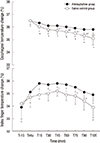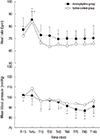1. Matsukawa T, Sessler DI, Sessler AM, Schroeder M, Ozaki M, Kurz A, Cheng C. Heat flow and distribution during induction of general anesthesia. Anesthesiology. 1995; 82:662–673.
2. Annadata R, Sessler DI, Tayefeh F, Kurz A, Dechert M. Desflurane slightly increases the sweating threshold but produces marked, nonlinear decreases in the vasoconstriction and shivering thresholds. Anesthesiology. 1995; 83:1205–1211.
3. Valeri CR, Feingold H, Cassidy G, Ragno G, Khuri S, Altschule MD. Hypothermia-induced reversible platelet dysfunction. Ann Surg. 1987; 205:175–181.
4. Kurz A, Sessler DI, Lenhardt R. Perioperative normothermia to reduce the incidence of surgical-wound infection and shorten hospitalization: Study of Wound Infection and Temperature Group. N Engl J Med. 1996; 334:1209–1215.
5. Frank SM, Beattie C, Christopherson R, Norris EJ, Perler BA, Williams GM, Gottlieb SO. Unintentional hypothermia is associated with postoperative myocardial ischemia: the Perioperative Ischemia Randomized Anesthesia Trial Study Group. Anesthesiology. 1993; 78:468–476.
6. Nguyen NT, Fleming NW, Singh A, Lee SJ, Goldman CD, Wolfe BM. Evaluation of core temperature during laparoscopic and open gastric bypass. Obes Surg. 2001; 11:570–575.
7. Bessell JR, Karatassas A, Patterson JR, Jamieson GG, Maddern GJ. Hypothermia induced by laparoscopic insufflation: a randomized study in a pig model. Surg Endosc. 1995; 9:791–796.
8. Kwak HJ, Min SK, Yi IK, Chang YJ, Kim JY. Comparison of the effects of sevoflurane and propofol on core body temperature during laparoscopic abdominal surgery. Korean J Anesthesiol. 2011; 61:133–137.
9. Wang LC. Effects of feeding on aminophylline induced supra-maximal thermogenesis. Life Sci. 1981; 29:2459–2466.
10. Wang LC, Anholt EC. Elicitation of supramaximal thermogenesis by aminophylline in the rat. J Appl Physiol Respir Environ Exerc Physiol. 1982; 53:16–20.
11. Zimmermann B, Diebold G, Galbraith J, Whitmore W, Okamoto M, Robinson JB, Young BA, Murdoch G, Mosenthin R, Christopherson RJ. Effect of aminophylline on metabolic and thermoregulatory responses during hypothermia associated with cold exposure in lambs. Can J Anim Sci. 2003; 83:739–748.
12. Brock L. The importance of environmental conditions, especially temperature, in the operating room and intensive care ward. Br J Surg. 1975; 62:253–258.
13. Lee TF, Wang LC, Russell JC. Enhancement of cold-stimulated thermogenesis in the corpulent rat (LA/N cp) by aminophylline. Am J Physiol. 1987; 252:R737–R742.
14. Vestal RE, Eiriksson CE Jr, Musser B, Ozaki LK, Halter JB. Effect of intravenous aminophylline on plasma levels of catecholamines and related cardiovascular and metabolic responses in man. Circulation. 1983; 67:162–171.
15. Dulloo AG, Seydoux J, Girardier L. Peripheral mechanisms of thermogenesis induced by ephedrine and caffeine in brown adipose tissue. Int J Obes. 1991; 15:317–326.
16. Wang LC, Lee TF. Enhancement of maximal thermogenesis by reducing endogenous adenosine activity in the rat. J Appl Physiol (1985). 1990; 68:580–585.
17. Wang LC, Jourdan ML, Lee TF. Mechanisms underlying the supra-maximal thermogenesis elicited by aminophylline in rats. Life Sci. 1989; 44:927–934.
18. Schwinn DA, McIntyre RW, Reves JG. Isoflurane-induced vasodilation: role of the alpha-adrenergic nervous system. Anesth Analg. 1990; 71:451–459.
19. Sellgren J, Pontén J, Wallin BG. Percutaneous recording of muscle nerve sympathetic activity during propofol, nitrous oxide, and isoflurane anesthesia in humans. Anesthesiology. 1990; 73:20–27.
20. Ikeda T, Ozaki M, Sessler DI, Kazama T, Ikeda K, Sato S. Intraoperative phenylephrine infusion decreases the magnitude of redistribution hypothermia. Anesth Analg. 1999; 89:462–465.
21. Hynson JM, Sessler DI. Intraoperative warming therapies: a comparison of three devices. J Clin Anesth. 1992; 4:194–199.
22. Sessler DI, McGuire J, Hynson J, Moayeri A, Heier T. Thermoregulatory vasoconstriction during isoflurane anesthesia minimally decreases cutaneous heat loss. Anesthesiology. 1992; 76:670–675.
23. Kurz A, Sessler DI, Christensen R, Dechert M. Heat balance and distribution during the core-temperature plateau in anesthetized humans. Anesthesiology. 1995; 83:491–499.











